At FARO’s 3D Documentation Conference for the Americas this year, they had no major hardware updates to announce. (Though let’s not forget they announced the new Focus X 130 earlier this year). This had quite a nice effect on the keynotes: it kept FARO’s talk on their big picture plans for the near future, and it meant we saw lots of presentations on the possibilities of laser scanning in general. A mostly full room saw presentations on some very cool uses for the technology, including bits on scanning ultimate fighting champions and rock bands, scanning for Apple iPhone ads and commercials, and preserving buildings central to US space history.
Turnout was good, attendees were enthused, and the exhibit floor was busy, as you can (hopefully) see in the poorly exposed smartphone photograph above. I promise to upgrade soon.
As cool as the opening presentations were, the conference wasn’t all flash–a few of the keynotes featured some impressive use cases, and the conference included blocks of instructive workshop sessions. Most I attended were clear and direct enough for a newcomer like me to understand. By the end I was even considering a career in laser scanning…
These sessions felt like a delicate balancing act, because in addition to supplying an introduction to the newcomers, they provided a valuable service to the old pros. The workshops gave more experienced attendees a forum for comparing “war” stories and tips, as well as a chance to bend the ears of the bigwigs at FARO about their needs and hopes for software and hardware going forward. FARO’s own “Meet the FARO Experts” sessions, for instance, had the feeling of a discussion as much as a presentation.
This mixture of new blood and old pros may be true of most conferences (it certainly has been true of many conferences I’ve been to so far), but it bears mentioning because it gives a sense of where the industry stands at large. What we have is a mixture of early adopters who are still pushing the development of the software and newcomers who want to see what this scanning business is all about, who want to learn what to do once they get their hands on a point cloud.
I spoke to many architects and providers who seemed convinced of the technology by conference end, and many who came in with a basic knowledge of how to use the technology and left with a lot of ideas.
So, without further ado, here are some of my major takeaways:
1. FARO knows it’s about the software, too. Using the actual scanner has become relatively easy over the past few years, thanks to hardware developments like FARO’s Focus. The workflow to process the resulting data, on the other hand, is not as developed as many users would like it to be.
FARO seems focused on changing this. They recently acquired CAD Zone to aid in their quest to “personalize” software and workflows to the specific industry where it’s being used, and maybe someday even to the individual customer who is using it. Take into account the attention paid to their 3D App Center during the conference and the subtle but persistent mention of the new targetless registration features in Scene 5.3, and it becomes clear that FARO is focused on making scanning software as dead simple as many scanners are.
2. Cloud-to-cloud registration could be a big deal. As I mentioned, FARO used the conference to showcase the targetless registration features in Scene 5.3, features which could theoretically save quite a bit of time and money on projects that involve many scans. Of the two targetless registration methods, though, more attention was definitely paid to the cloud-to-cloud registration.
However, it seems that FARO anticipated some hesitance on the part of their users to actually start using cloud-to-cloud registration, because many of the conference presenters included stories in their talks about how they’ve been surprised by the accuracy of cloud-to-cloud registration, how it’s saved them time and money, and how they plan on using it for most of their projects going forward.
But it’s not just the presenters who believed in cloud-to-cloud–I talked to a lot of attendees who were keen to get home and try it out now that they know what it can do. There are, of course, times where targetless registration methods wouldn’t work (for instance, I’ve been told it’s not ideal when the scan data needs to be georeferenced), but for a great majority of projects, the FARO conference left me believing it has a pretty big future.
3. People like FARO’s strategy. I spoke to a number of providers and users at meals who were happy that FARO seems to be keeping up with the trends in 3DLS technology (handheld scanners, UAVs, and so on) and incorporating them into their big-picture strategy going forward. They were also pleased that FARO is being aggressive about making less expensive scanners and “democratizing” the technology, as the costs to get into the 3DLS game can still be prohibitive. Some attendees wondered if FARO has any interest in responding directly to the growing number of consumer-grade scanners coming on the market with similar (but possibly more precise) products of their own. On that point, I suppose only time will tell.






